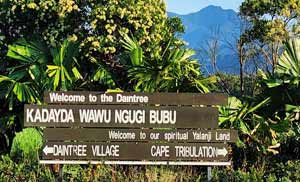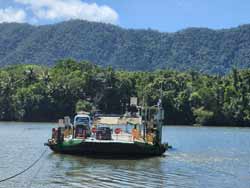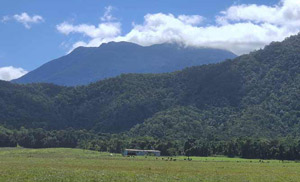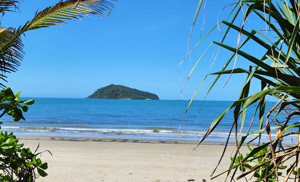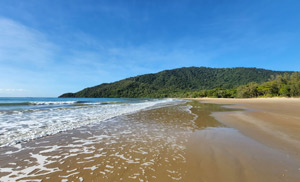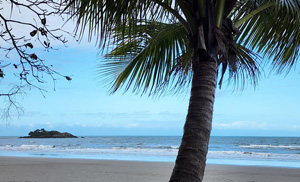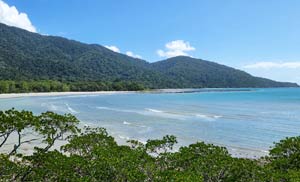
This phenomenal insect has wings but doesn’t fly. It can produce female young without mating! If threatened, it sprays out a sweet smelling but stinging spray. Its vibrant green colour should make it stand out in a crowd, but it becomes almost invisible in its chosen foliage – the leaves of certain pandanus species.
And, while they’re quite common on the coastal fringes and boardwalks of the Daintree Coast, most visitors never get to see them. Mainly, because they don’t know what to look for. Let’s fix that now!
This phantastic phasmid is called the Peppermint Stick insect (“Megacrania batesii”), aka Peppermints. Phasmid means phantom or ghost and is is the name given to the entire family of Stick Insects. “Megacrania” simply means large head, and “Batesii after Henry Bates, the naturalist who described the Peppermint way back in 1865. By the way, Bates was a friend and colleague of Alfred Russell Wallace, arguably the first person (Charles Darwin?) to publicly articulate the theory of evolution by natural selection. Also, the imaginary line dividing many Asian and Australiana fauna.
If you disturb a Peppermint, you’ll cop a squirt of a surprisingly sweet-smelling spray of white gooey peppermint. Just enough to sting the eyes of a preying spider or bird, or surprise the over-curious tourist. It can direct the spray in different directions, so please don’t try it. Also, too many predators can stress the little beastie.
And the Peppermint colour is rare and amazing. It’s young are a light blueish-green(jade-ish?), growing into a richer green – perfectly camouflaged – as it matures.

In Australia, Peppermints live mainly north of the Daintree River and this is where you’re most likely to see them. Although, if you travel to New Guinea or the Solomon Islands, you’ll see many more of the same, plus similar species. Oddly, there are three small Peppermint populations south of Cairns, all members of which are female. Yes, Amazon tribes!! But more of that later.
Peppermints are always associated with a particular diet – the serrated-leafed pandanus plant, in which they also hide skilfully on the inside barrel of the spiky leaf.
Mostly, they feed on the screw pandanus (pandanus spiralis), although I’ve also seen them among another pandanus (Pandanus monticola) at Madja Botanical Walk, off Cape Tribulation Road. Researchers from University of New South Wales have observed them eating three different pandanus species, so it’s a pandanus-only diet. They definitely do not feed on the almost identical-looking sedges – also with serrated edges – in the swampy waters of Dubuji boardwalk.
Peppermints and one of the Katydids are among the very few insects that eat pandanus leaves. So, here’s a clue to spotting a Peppermint. Look firstly for chewed leaves. If they’re fresh (ie the inside edges still green and not browned by age), you might actually see a Peppermint on nearby leaves.
Peppermints are generally diurnal (daytime), are very alert and have sharp eyesight. When approached, they’ll often quickly slide down backwards like a firefighter down a pole, to shelter among the spikey leaf edges down the “barrel” of the pandanus clump. Because of this, predators are not much of a problem.
A photo here shows a couple in mating position, with the male piggy-backing on the much larger female. They can do this for hours – firstly, actually mating, then followed by the male just resting or more likely preventing other males from mating (mate guarding). Anything to safeguard his personal gene pool!! No competitors wanted around here! So look closely! Are they inextricably entwined in true mating behaviour or just piggy-backing? Mating, guarding or just resting??
But even when they are coupled together like the two in the photo, they are almost perfectly camouflaged among the pandanus leaves.
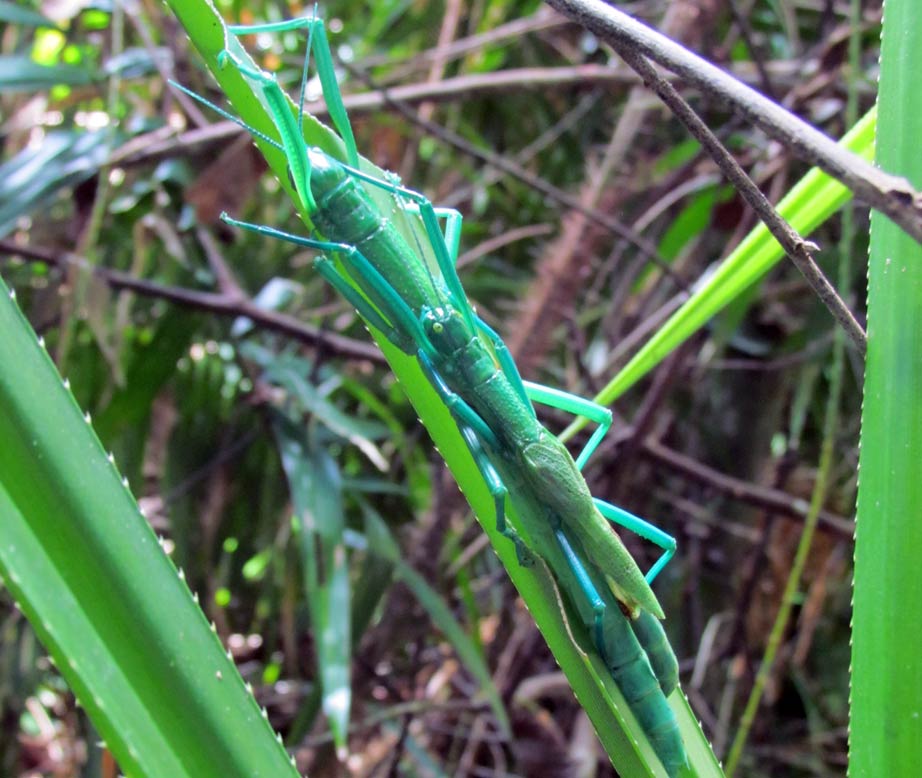
Note the brown adult wings. The male is much smaller than the female with a better wing to size ratio– his wings are proportionately larger. Basically this means that the male is more mobile travelling between plants, although as evidenced by Dr Russell Bondurianski and his colleagues from the University of NSW, Peppermints don’t really fly!
From time to time, Peppermints need to move to another food source, often just a metre or two away. Females don’t move as much, but males generally parachute down, crawl along the ground, then climb up a nearby pandanus plant. Dr Bondurianski has observed them travelling up to 10 metres this way. Being larger, females especially are often confined to their own little pandanus cluster. As a consequence, males will occasionally forage too far from the females and get separated without mating.
Either way, the female can still produce and lay eggs, fertilised or not, which she just drops down into the leaf barrel to hatch a few months later when the warmer, wetter weather comes along.
And here’s where a very special process called parthenogenesis, or literally virgin birth, enters the picture. The unfertilised Peppermint eggs will still produce viable young – but they will all be female – and therefore clones! This can continue for more than one generation, until the genders are re-united. Hence the three populations of female Peppermint stick insects to the south of Cairns. How did they get there? Some females were probably physically relocated many years ago and have been re-producing ever since.
Many insect species actually have this parthenogenesis – from ants to bees. All-female species, and all therefore clones, have also been documented in fish, amphibians, reptiles and birds. But not yet mammals!
How did Peppermints get to Australia (from New Guinea or the Solomons) in the first place? Presuming that Peppermints must “rafted” by sea (presumably as a cluster of eggs on a clump of pandanus dislodged by a cyclone) for longer journeys, and also used high winds for shorter trips, along coastlines, and between islands. Their flightlessness (and the range of pandanus) would account for their limited coastal range. And it would partially explain the need to be self-contained through parthenogenesis.
Why have some winged insects lost the ability to fly? The great evolutionist Charles Darwin noted that quite a few island island insects have evolved to lose flight.
More locally, Entomologists have observed flight loss in some species in windy, high altitude Daintree rainforest conditions. Particularly in tropical rainforests, many plant species grow in small clusters, far removed from other food sources. So, in these high wind conditions, individuals with better flight might attempt to find another food source or mate, fail to find one and starve.
So, poorer flight has become an advantage and the gene pool evolves gradually to favour poorer flight. Survival of the unfittest? In a way, but actually, survival of the fittest, selecting for successful behaviour.

Where to find Peppermints?
Where can you find some of these Peppermint Stick Insects? Firstly, you’ll need to travel north of the Daintree River to almost anywhere close to the Daintree Coast, close to the coast itself and where there are pandanus species with its spikey leaves close to ground level.
The tree and bush-types Pandanus grow in many places, especially swamp land. Peppermints seem to like the slightly cooler spots around the beaches. Look inside a smaller pandanus bush for the telltale signs of pandanus leaves that have been freshly eaten, preferably a low-growing one to get a good vantage point. Peppermints often escape the heat, or a predator, by sliding down into the base, so you’ll most likely see them higher in the leaf.
Peppermints are most observable in the swampy areas along Dubuji Boardwalk/Myall Beach in Cape Tribulation. Near Cape Trib beach, the Kulki boardwalk up to the lookout platform has small, young pandanus and is one of the better Peppermint spotting sites. Madja boardwalk has a pandanus cluster with Peppermints in the swampy area near the start of the walk. You’re unlikely to see them at Jindalba (“Foot of the Mountain”) boardwalk. It’s too high and too far from the coast, with just isolated pandanus.
There is another special place where you can see not just Peppermints, but also an amazing range of other Australian and world insects. It’s the Daintree Entomological Museum in Diwan, just off Turpentine Road, 30 minutes drive from the Daintree Ferry Crossing.
The Museum has spiny leaf insects, Goliath Stick Insects and, if you’re lucky, a caterpillar of the Giant Hercules Moth. Under glass are wonderful world butterflies, bugs and beetles. As a bonus, some of the owner’s unique and incredibly detailed artwork is well displayed. Ask to see the amazing mask highlighting the iridescent blue wings of the Ulysses butterfly.
So, there are plenty of nature’s phenomenal delights on the Daintree Coast.

Mike D’Arcy
D’Arcy of Daintree
Mike spent many years as an interpretive Wet Tropics Tour Guide running his own business D’Arcy of Daintree 4WD tours. Now retired. Mike has a wealth of knowledge on the Daintree Coast region and continues to share this via his audio tours and blog posts on the Daintree Coast website.
The Daintree Coast website is your guide to this amazing region. Browse our website for local insight, history and information guides to local destinations. Explore our directory for activities and things to do, see and experience. Find Daintree Rainforest accommodation, cafes and restaurants and must-see places.
Daintree Coast – Be Amazed.
